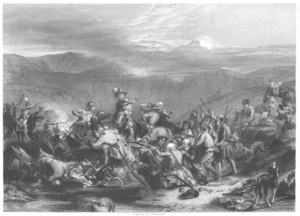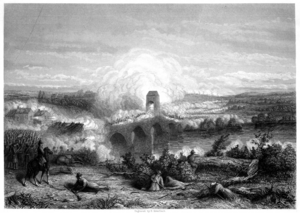Robert Hamilton of Preston facts for kids
Quick facts for kids
Robert Hamilton of Preston
|
|
|---|---|
| Allegiance | |
| Battles/wars | Battle of Drumclog Battle of Bothwell Bridge |
Robert Hamilton (1650–1701) was a key leader of the Covenanters in Scotland. The Covenanters were a group who wanted to protect the Presbyterian Church from changes made by the king. Robert was the second son of Sir Thomas Hamilton. He studied at Glasgow University. Hamilton became an important figure in the Covenanter movement. He led forces in major battles like Drumclog and Bothwell Bridge. After a defeat, he went to Holland. He returned to Scotland later but did not support the new king, William of Orange. This was because the king had not signed a special agreement with the Covenanters. Robert Hamilton died at the age of 51 and never married.
Contents
Who Was Robert Hamilton?
Robert Hamilton was the younger son of Sir Thomas Hamilton of Preston Tower. His father was a Royalist, meaning he supported the king. Sir Thomas fought in battles like Dunbar in 1650. Robert, however, chose a different path. He was educated at the University of Glasgow. There, he was taught by Gilbert Burnet, whose sister was his stepmother. Robert soon started attending secret religious meetings called conventicles. He became a very strong supporter of the Covenanter cause.
Leading the Covenanters in 1679
In 1679, Robert Hamilton joined with other Covenanter leaders. These included Thomas Douglas and Hackston of Rathillet. They wrote a statement known as the "Rutherglen Declaration". They planned to post it in Glasgow on the king's birthday. However, the king's troops, led by John Graham of Claverhouse, arrived. So, they went to Rutherglen instead. There, they put out a bonfire lit for the king. They then lit their own fire and burned all the laws and announcements made since the king returned to power. After this bold act, they moved towards Loudoun Hill. They planned to hold a large armed meeting there.
The Battle of Drumclog
Claverhouse's troops suddenly came upon the Covenanters. The Covenanters quickly sent their women and children away. They then prepared for battle on a farm called Drumclog. Robert Hamilton was officially in charge. However, more experienced leaders like Hackston and Cleland actually led the different groups of Covenanter fighters. They managed to defeat Claverhouse's forces.
After the battle, Hamilton showed some strong leadership. He later explained his actions in a document from 1685. He said that before the fight, he had ordered that no mercy should be given to the enemy.
The Battle of Bothwell Bridge
After Drumclog, the Covenanters tried to attack Glasgow. But the king's troops had blocked the city, and the Covenanters were easily pushed back. They then retreated to Hamilton. Claverhouse's forces were too weak to attack them there. So, the Covenanters set up a camp. Robert Hamilton claimed credit for the victory at Drumclog. He took command of the Covenanter army without much discussion.
Inside the camp, there were many arguments and religious debates. Later, John Welch arrived with more men. Welch was open to making a deal with the government. He thought both forms of church rule, episcopacy and presbyterianism, could be allowed. Hamilton and his supporters strongly disagreed with this idea.
The government forces, led by the Duke of Monmouth, then appeared. Welch and others wrote a statement hoping to stop the fighting. This statement is known as the Hamilton Declaration. Robert Hamilton also signed a request to Monmouth. He later said he thought it was the work of another Covenanter leader, Donald Cargill.
When the Hamilton Declaration was presented, the armies faced each other. They were on opposite sides of the River Clyde at Bothwell Bridge. Monmouth refused to talk unless the Covenanters put down their weapons. Hamilton seemed to prepare for a long fight. But when the battle started, his bravery seemed to disappear. He ordered Hackston to retreat when the bridge was attacked. He himself rode away with the horsemen. He left the foot soldiers to defend themselves. Many people questioned his courage after this. Some historians called him a "coward" and said his actions were "ill conduct."
Life After the Battles
After the defeat at Bothwell Bridge, Hamilton escaped to Holland. He was declared an outlaw, meaning he could be arrested and executed if caught. In Holland, he worked for the "persecuted true presbyterian church in Scotland." He traveled to Germany and Switzerland to gain support. In 1683, he helped James Renwick become a minister for the Presbyterian Church in Scotland.
When the Glorious Revolution happened in 1688, Hamilton returned to Scotland. His outlaw status was removed. He became a baronet after his brother Sir William died. However, he refused to claim his brother's lands. He said it would mean accepting a king who had not made a special agreement with the Covenanters.
Hamilton remained important to the most extreme Covenanters. In 1689, he spoke out against a decision by some Covenanters. They agreed to form a new army regiment called the Cameronian regiment.
In 1692, Hamilton was suspected of writing a new "Sanquhar declaration". He was arrested in September and held prisoner in Edinburgh and Haddington. He was questioned many times. He refused to accept the authority of the new king and queen, William and Mary. However, he was set free in May 1693. He was allowed to live peacefully until his death on October 20, 1701.



